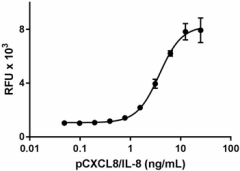- Regulatory Status
- RUO
- Other Names
- Small inducible cytokine subfamily B, member 8 (SCYB8), Monocyte derived neutrophils chemotactic factor (MDNCF), Neutrophil-activating peptide 1 (NAP1), Granulocyte chemotactic protein 1 (GCP1), Chemokine, CXC motif, ligand 8

-

Recombinant Porcine CXCL8/IL-8 chemoattracts human neutrophils in a dose-dependent manner. The ED50 for this effect is = 2 - 10 ng/mL.
| Cat # | Size | Price | Quantity Check Availability | ||
|---|---|---|---|---|---|
| 782901 | 5 µg | $112.00 | |||
| 782903 | 20 µg | $253.00 | |||
IL-8 (CXCL8) was originally recognized as a neutrophil-activating protein on the basis of two in vitro effects, chemotaxis and the release of granule enzymes. Porcine IL-8 is generated as a precursor of 103 amino acids. Porcine IL-8 is 75 and 81% similar to human and rabbit IL-8, respectively. IL-8 is one of the ELR (Glu-Leu-Arg) motif-positive CXC-chemokines and shares similarities with angiogenic cytokines. The ELR motif is just before the characteristic CXC sequence of cysteine residues. Most of the chemokines form noncovalent dimers, and IL-8 is functional as a monomer and as a dimer. The monomeric form binds with higher affinity to the CXCR1 than the dimeric form. IL-8 binds to CXCR1 and CXCR2. CXCR1 is shared with CXCL6 and CXCR2 is shared with CXCL1, CXCL2, CXCL3, CXCL5, CXCL6, and CXCL7. The CXCR1 receptor has two binding sites for IL-8, the binding site I located in the amino terminal domain, and the binding site II that includes one or two extracellular loops of CXCR1. IL-8/CXCR1 interaction induces tumor proliferation, and IL-8/CXCR2 interaction promotes angiogenesis in prostate cancer.
Product Details
- Source
- Porcine CXCL8, amino acid Ala26 – Gln103 (Accession #P26894) was expressed in E.coli.
- Molecular Mass
- The 78 amino acid recombinant protein has a predicted molecular mass of approximately 9.0 kD. The predicted N-terminal amino acid is Ala.
- Purity
- >95%, as determined by Coomassie stained SDS-PAGE.
- Formulation
- Lyophilize from sterile 0.22 µm filtered protein solution is in PBS pH 7.2.
- Endotoxin Level
- Less than 1 EU per µg protein as determined by the LAL method.
- Concentration
- Lyophilized recombinant protein is at 5 and 20 µg total protein
- Storage & Handling
- Unopened vial can be stored between 2°C and 8°C for one month, at -20°C for six months, or at -70°C for one year. For maximum results, quick spin vial prior to opening. Reconstitute the protein in sterile water at 0.1 mg/mL. The protein can be aliquoted and stored at -20°C to -70°C. Stock solutions can also be prepared at 50 - 100 µg/mL in sterile buffer (PBS, HPBS, DPBS, or EBSS) containing carrier protein such as 0.2 - 1% BSA or HSA and stored in working aliquots at -20°C to -70°C. Avoid repeated freeze/thaw cycles.
- Activity
- Recombinant Porcine CXCL8/IL-8 chemoattracts human neutrophils in a dose-dependent manner. The ED50 for this effect is = 2- 10 ng/mL
- Application
-
Bioassay
- Application Notes
-
BioLegend carrier-free recombinant proteins provided in lliophylized format are shipped on blue ice.
Antigen Details
- Structure
- Chemokine
- Distribution
-
Macrophages, epithelial cells, airway smooth muscle cells, and endothelial cells.
- Function
- Chemoattraction and activation of neutrophils and granulocytes in inflammation. Induced by inflammatory cytokines such as TNFa, IL-1a; also induced by LPS
- Interaction
- Neutrophils, monocytes/macrophages, T and NK cells, mast cells, and endothelial cells.
- Ligand/Receptor
- CXCR1, CXCR2
- Bioactivity
- Recombinant Porcine CXCL8/IL-8 chemoattracts human neutrophils in a dose-dependent manner.
- Cell Type
- Th17
- Biology Area
- Cell Biology, Immunology, Neuroinflammation, Neuroscience, Stem Cells
- Molecular Family
- Cytokines/Chemokines
- Antigen References
-
- Burrows SD, et al. 1994. Biochemistry. 33:12741.
- Hoffmann E, et al. 2002. J Leukoc Biol. 2002 72:847.
- Araki S, et al. 2007. Cancer Res. 67: 6854.
- Ravindran A, et al. 2009. Biochemistry. 48:8795.
- Das ST, et al. 2010. PLoS One. 5:e11754.
- Baggiolini M. 2015. Front Immunol. 6:285.
- Liu Q, et al. 2016. Cytokine Growth Factor Rev. 31:61.
- Gene ID
- 396880 View all products for this Gene ID
- UniProt
- View information about CXCL8 on UniProt.org
